1998 PONTIAC GRAND PRIX air condition
[x] Cancel search: air conditionPage 348 of 402
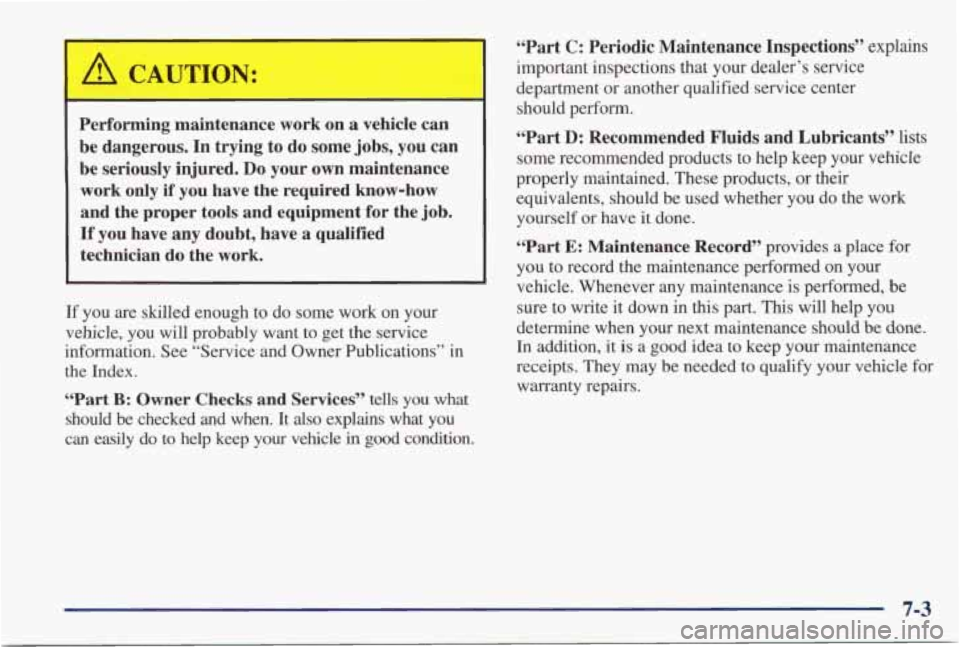
A CAUTION:
Performing maintenance work on a vehicle can
be dangerous. In trying to do some jobs, you can
be seriously injured.
Do your own maintenance
work only
if you have the required know-how
and the proper tools and equipment for the job.
If you have any doubt, have
a qualified
technician
do the work.
If you are skilled enough to do some work on your
vehicle, you will probably want to get the service
information. See “Service and Owner Publications” in
the Index.
“Part B: Owner Checks and Services’’ tells you what
should be checked and when. It
also explains what you
can easily
do to help keep your vehicle in good condition. “Part
C: Periodic Maintenance Inspections”
explains
important inspections that your dealer’s service department or another qualified service center should perform.
“Part D: Recommended Fluids and Lubricants” lists
some recommended products to help keep your vehicle
properly maintained. These products, or their
equivalents, should be used whether
you do the work
yourself or have it done.
“Part E: Maintenance Record” provides a place for
you to record the maintenance performed on your
vehicle. Whenever any maintenance is performed,
be
sure to write it down in this part. This will help you
determine when your next maintenance should be done.
In addition,
it is a good idea to keep your maintenance
receipts. They may be needed
to qualify your vehicle for
warranty repairs.
Page 349 of 402
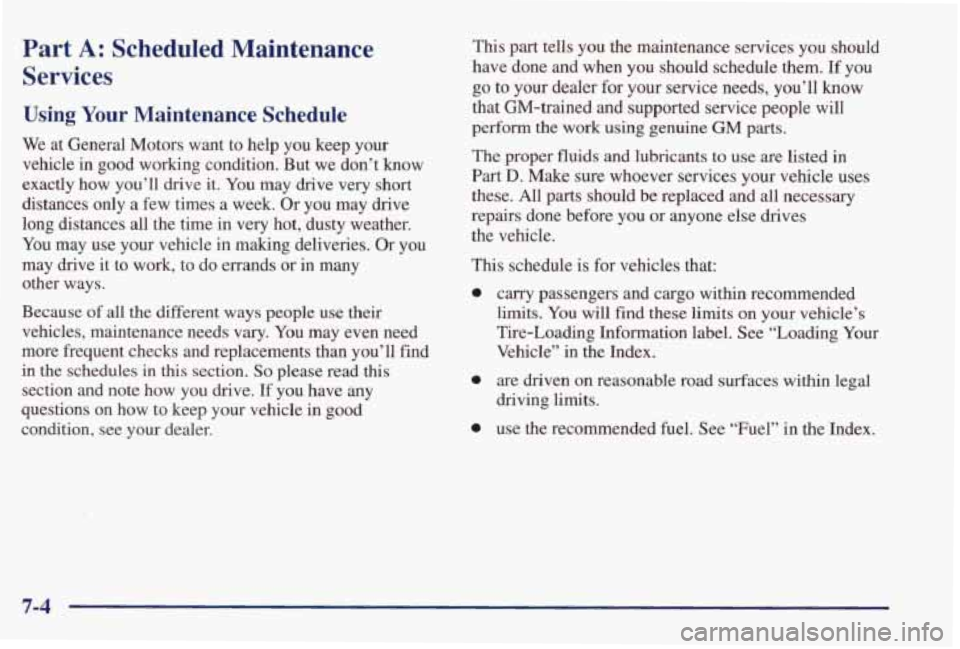
Part A: Scheduled Maintenance
Services
Using Your Maintenance Schedule
We at General Motors want to help you keep your
vehicle in good working condition. But we don’t know
exactly how you’ll drive it. You may drive very short
distances only a few times a week. Or you may drive
long distances all the time in
very hot, dusty weather.
You may use your vehicle in making deliveries. Or you
may
drive it to work, to do errands or in many
other ways.
Because
of all the different ways people use their
vehicles, maintenance needs vary. You may even need
more frequent checks and replacements than you’ll find
in the schedules in this section. So please read this
section and note how you
drive. If you have any
questions
on how to keep your vehicle in good
condition, see your dealer.
This part tells you the maintenance services you should
have done and when you should schedule them. If
you
go to your dealer for your service needs, you’ll know
that GM-trained and supported service people will
perform
the work using genuine GM parts.
The proper fluids and lubricants
to use are listed in
Part D. Make sure whoever services your vehicle uses
these. All parts should be replaced and all necessary
repairs done before you or anyone else drives
the vehicle.
This schedule
is for vehicles that:
0
0
0
carry passengers and cargo within recommended
limits. You will find these limits on your vehicle’s
Tire-Loading Information label. See “Loading Your
Vehicle”
in the Index.
are driven on reasonable road surfaces within legal
driving limits.
use the recommended fuel. See “Fuel” in the Index.
7-4
Page 350 of 402
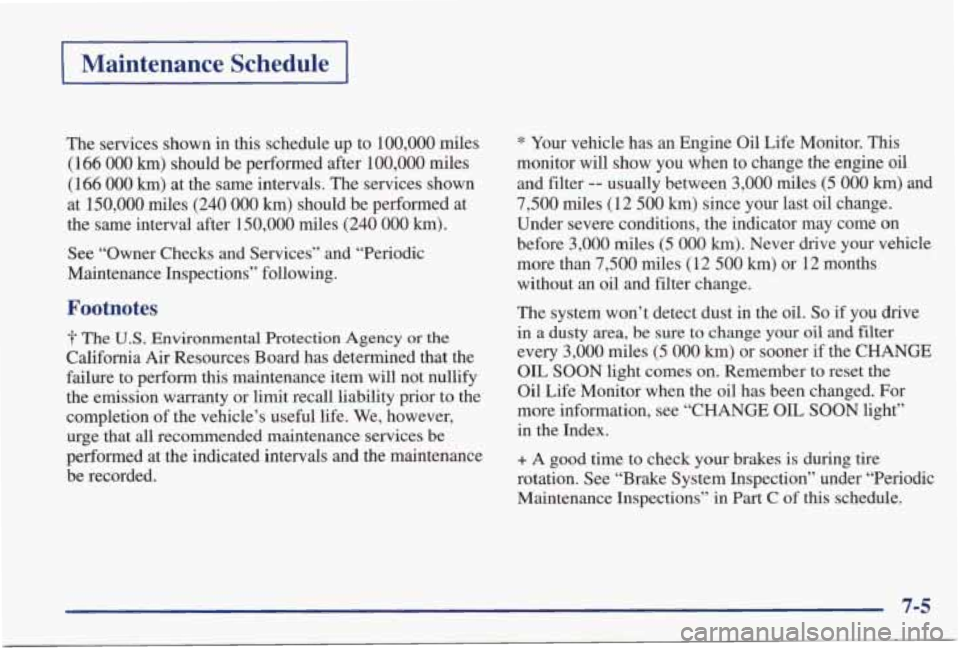
Maintenance Schedule
The services shown in this schedule up to 100,000 miles
(166
OOO km) should be performed after 100,000 miles
(166
000 km) at the same intervals. The services shown
at
150,000 miles (240 000 km) should be performed at
the same interval after 150,000 miles
(240 000 km).
See “Owner Checks and Services” and “Periodic
Maintenance Inspections” following.
Footnotes
? The US. Environmental Protection Agency or the
California Air Resources Board has determined that the
failure to perform
this maintenance item will not nullify
the emission warranty or limit recall liability prior
to the
completion
of the vehicle’s useful life. We, however,
urge that
all recommended maintenance services be
performed at the indicated intervals and the maintenance be recorded.
* Your vehicle has an Engine Oil Life Monitor. This
monitor will show you when to change the engine oil
and filter
-- usually between 3,000 miles (5 OOO km) and
7,500 miles (12 500 km) since your last oil change.
Under severe conditions, the indicator may come
on
before 3,000 miles (5 000 km). Never drive your vehicle
more than
7,500 miles (12 500 km) or 12 months
without
an oil and filter change.
The system won’t detect dust
in the oil. So if you drive
in
a dusty area, be sure to change your oil and filter
every 3,000 miles (5 000 km) or sooner if the CHANGE
OIL SOON light comes on. Remember to reset the
Oil Life Monitor when the oil has been changed. For
more information, see “CHANGE
OIL SOON light”
in the Index.
+ A good time to check your brakes is during tire
rotation. See “Brake System Inspection” under “Periodic
Maintenance Inspections”
in Part C of this schedule.
Page 351 of 402
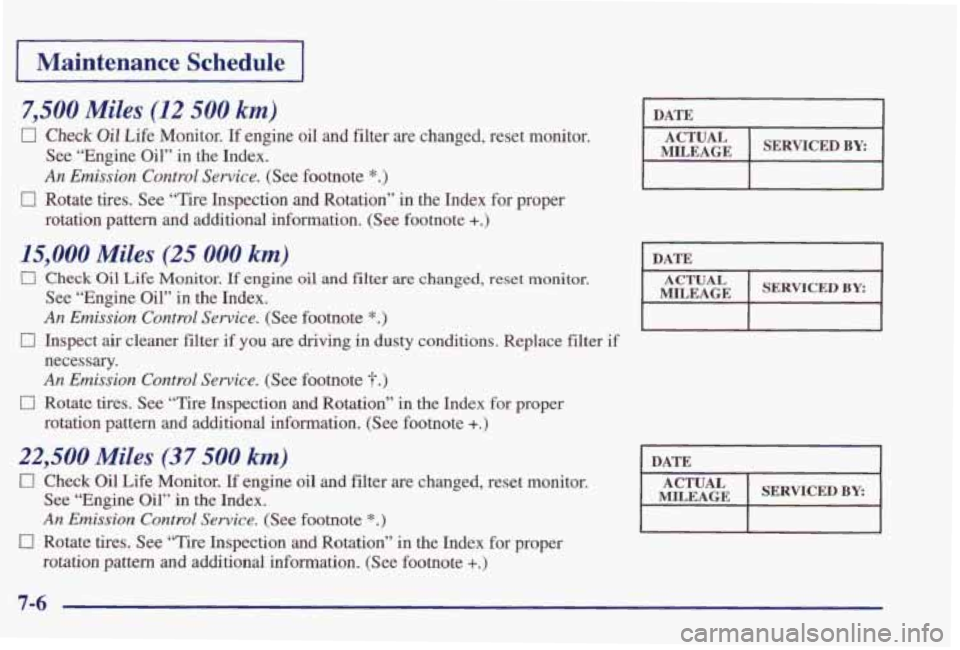
Maintenance Schedule
7,500 Miles (12 500 km)
0 Check Oil Life Monitor. If engine oil and filter are changed, reset monitor.
See “Engine Oil”
in the Index.
An Emission Control Service. (See footnote *.)
rotation pattern and additional information. (See footnote +.)
0 Rotate tires. See “Tire Inspection and Rotation” in the Index for proper
I DATE I
15,000 Miles (25 000 km)
0 Check Oil Life Monitor. If engine oil and filter are changed, reset monitor.
See “Engine Oil” in the Index.
An Emission Control Service. (See footnote *.)
necessary.
An Emission Control Service. (See footnote $.)
rotation pattern and additional information. (See footnote +.)
0 Inspect air cleaner filter if you are driving in dusty conditions. Replace filter if
0 Rotate tires. See “Tire Inspection and Rotation” in the Index for proper
22,500 Miles (37 500 km)
0 Check Oil Life Monitor. If engine oil and filter are changed, reset monitor.
See “Engine
Oil” in the Index.
An Emission Control Service. (See footnote *.)
rotation pattern and additional information. (See footnote +.)
0 Rotate tires. See “Tire Inspection and Rotation” in the Index for proper
MILEAGE
7-6
Page 353 of 402
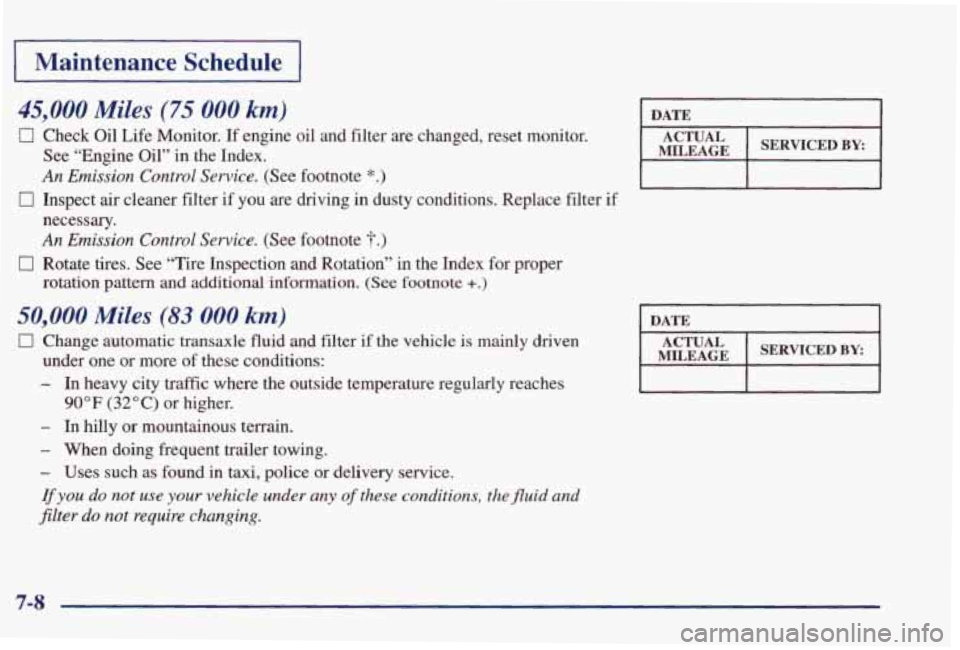
Maintenance Schedule
45,000 Miles (75 000 km)
0 Check Oil Life Monitor. If engine oil and filter are changed, reset monitor.
MILEAGE See “Engine Oil“ in the Index.
An Emission Control Service. (See footnote *.)
0 Inspect air cleaner filter if you are driving in dusty conditions. Replace filter if
necessary.
An Emission Control Service. (See footnote T.)
rotation pattern and additional information. (See footnote +.)
0 Rotate tires. See “Tire Inspection and Rotation” in the Index for proper
50,000 Miles (83 000 km)
0 Change automatic transaxle fluid and filter if the vehicle is mainly driven
under one or more of these conditions:
- In heavy city traffic where the outside temperature regularly reaches
- In hilly or mountainous terrain.
90°F (32°C) or higher.
- When doing frequent trailer towing.
- Uses such as found in taxi, police or delivery service.
rfyou do not use your vehicle under any of these conditions, the fluid and
filter
do not require changing.
7-8
Page 355 of 402
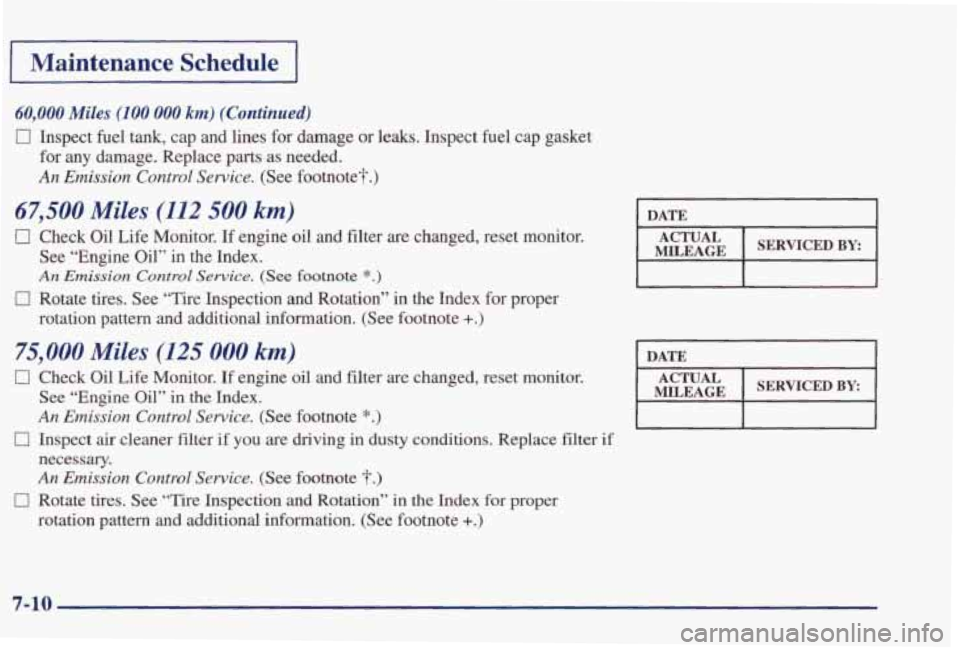
I Maintenance Schedule I
60,000 Miles (100 000 km) (Continued)
0 Inspect fuel tank, cap and lines for damage or leaks. Inspect fuel cap gasket
for any damage. Replace parts as needed.
An Emission Control Service. (See footnote”f)
67,500 Miles (112 500 km)
0 Check Oil Life Monitor. If engine oil and filter are changed, reset monitor.
See “Engine Oil” in the Index.
An Emission Control Sewice. (See footnote *.)
rotation pattern and additional information. (See footnote +.)
0 Rotate tires. See “Tire Inspection and Rotation” in the Index for proper
DATE 1
75,000 Miles (125 000 km)
0 Check Oil Life Monitor. If engine oil and filter are changed, reset monitor.
See “Engine Oil” in the Index.
An Emission Control Service. (See footnote *.)
0 Inspect air cleaner filter if you are driving in dusty conditions. Replace filter if
necessary.
An Emission Control Service. (See footnote “f)
rotation pattern and additional information. (See footnote +.)
0 Rotate tires. See “Tire Inspection and Rotation” in the Index for proper
7-10
Page 363 of 402
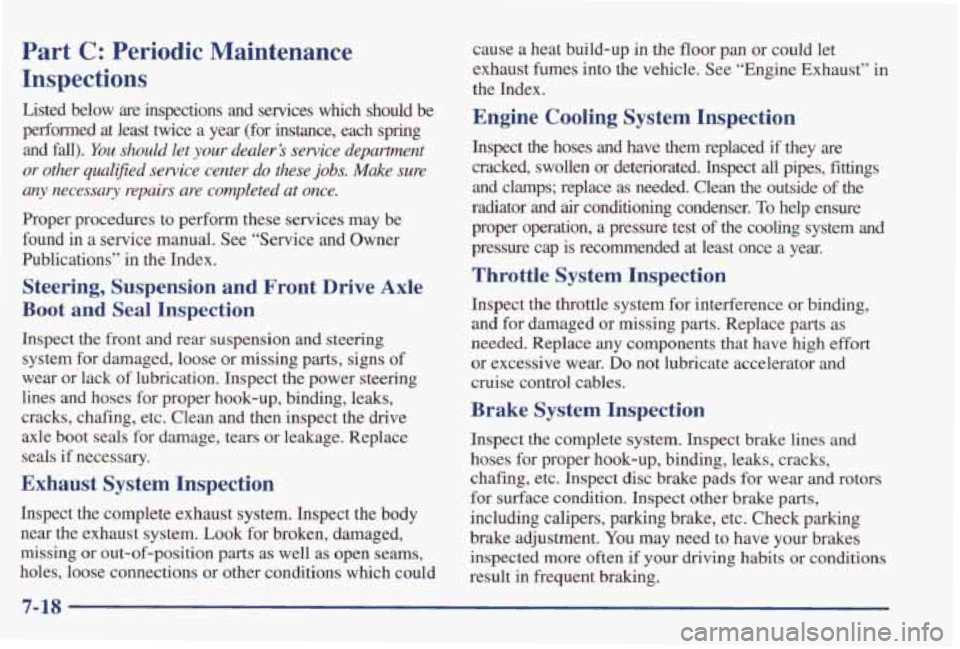
Part C: Periodic Maintenance
Inspections
Listed below are inspections and services which should be
perfunned at least twice a year (for instance, each spring
and
fall). You should let your dealer’s service department
or other qual$ed service center
do these jobs. Make sure
any necessary repairs are completed
at once.
Proper procedures to perform these services may be
found
in a service manual. See “Service and Owner
Publications” in the Index.
Steering, Suspension and Front Drive Axle
Boot
and Seal Inspection
Inspect the front and rear suspension and steering
system for damaged, loose or missing parts, signs of
wear or lack
of lubrication. Inspect the power steering
lines and hoses for proper hook-up, binding, leaks,
cracks, chafing, etc. Clean and then inspect the drive
axle boot seals for damage, tears or leakage. Replace
seals if necessary.
Exhaust System Inspection
Inspect the complete exhaust system. Inspect the body near the exhaust system. Look for broken, damaged,
missing or out-of-position parts
as well as open seams,
holes, loose connections or other conditions which could cause
a heat build-up in the floor pan or could let
exhaust fumes into the vehicle. See “Engine Exhaust’’ in
the Index.
Engine Cooling System Inspection
Inspect the hoses and have them replaced if they are
cracked, swollen or deteriorated. Inspect
all pipes, fittings
and clamps; replace
as needed. Clean the outside of the
radiator and
air conditioning condenser. To help ensure
proper
operation, a pressure test of the cooling system and
pressure cap is recommended at least once a year.
Throttle System Inspection
Inspect the throttle system for interference or binding,
and for damaged
or missing parts. Replace parts as
needed. Replace any components that have high
effort
or excessive wear. Do not lubricate accelerator and
cruise control cables.
Brake System Inspection
Inspect the complete system. Inspect brake lines and
hoses for proper hook-up, binding, leaks, cracks,
chafing, etc. Inspect disc brake pads for wear and rotors
for surface condition. Inspect other brake parts,
including calipers, parking brake, etc. Check parking
brake adjustment. You may need to have your brakes
inspected more often if your driving habits or conditions
result
in frequent braking.
7-18
Page 382 of 402

Section 9 Index
Accessory Power outlet ......................... 2-58
Adding Equipment to the outside of Your Vehicle ...... 6-3
AirBag ....................................... 1-23
How it Works ................................ 1-24
Readiness Light ......................... 1.23. 2.67
Air Cleaner .................................... 6-20
Air Conditioning ............................ 3.3. 3.7
Air Conditioning Refrigerants ..................... 6-70
Alignment and Balance. Tire ...................... 6-50
Aluminum Wheels. Cleaning ...................... 6-57
Anti-Lock
Brake System Warning Light
................ 2.67. 4.9
Brakes ...................................... 4-7
Anti.Theft. Radio .............................. 3-27
Appearance Care ............................... 6-52
Appearance Care Materials Chart .................. 6-60
ArbitrationPro gram .............................. 8-9
Arming Confirmation ............................. 2-15
Arming with the Power Lock Switch ................ 2-14
Ashtrays and Lighter ............................ 2-57
Audio Controls. Steering Wheel ................... 3-29
Audio Equipment. Adding ........................ 3-30
Audio Systems ................................. 3-10
Arming with the Remote Keyless Entry Transmitter .... 2-15
Automatic
Auxiliary Temp Control
....................... 3-4
Doorhcks .............................. 2.6. 2.47
Check ...................................... 7-15
Fluid ....................................... 6-22
Operation ................................... 2-21
Park Mechanism Check ....................... 7-17
Backglass Antenna ............................. 3-21
With a Trailer ................................ 4.37
Battery ....................................... 6-36
Jump Starting ................................. 5-3
Replacement, Remote Keyless Entry .............. 2-10
Resynchronizing, Remote Keyless Entry ........... 2-11
Warnings ........................... 5-3,5-5, 6-37
Battery Replacement ............................ 2-10
BatterySaver .................................. 2-43
BBB Auto Line ................................. 8-9
Before leaving on a Long Trip ..................... 4-24
Better Business Bureau Mediation ......... ..... 8-9
Blizzard ............................. .... 4-29
9-1